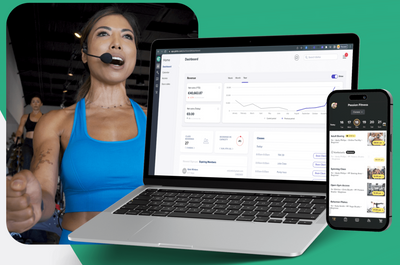
Opening a gym requires some financial heavy lifting. From securing a location to hiring staff, you need a plan for covering your expenses. Startup costs can vary based on size, location, and gym style, making it hard to know how much you’ll spend.
We'll explore the cost of opening a gym, helping to financially prepare you for the journey ahead.
GymBird Gym Startup Cost Calculator [FREE]
Free to use, built in Google Sheets
See costs depending on if you lease or buy a facility
Calculate annual costs to run a gym
Fully customizable
Why It's Important to Budget for the Cost to Open a Gym
A passion for fitness can only get you so far when starting a business. If you want to succeed, it's essential that you create a budget for your new gym. A staggering 81% of health and fitness studios fail within their first year, emphasizing the importance of financial planning to avoid the catastrophic consequences caused by unguided spending.
Randy Hetrick, Founder of OutFit, emphasizes the importance of a budget saying,
"It helps you forecast your revenue, determine how to best spend that revenue to meet your business goals, and to decrease overspending on purchases that aren't necessary. Plus, you can predict slow months and allocate your resources to offset them."
A well-planned budget can act as your business compass, steering you away from financial pitfalls and guiding you toward long-term success.
See also: How to Create a Business Plan for Your Gym
Understanding the Average Cost to Open a Gym in Detail
Factors like location, equipment, renovations and marketing all impact the cost of opening a gym. Gym owners can expect to pay anywhere from $50,000 to well over $1,000,000 depending on the type of facility they choose to open.
Let’s take a look at costs gym owners should plan for when starting their business. The costs listed below are average costs and are meant to give you a general idea of how much it costs to open a gym. Specific costs will vary from business to business.
Location
Your gym's physical location will be your largest upfront and ongoing expense. While you may be tempted to opt for properties in affordable locations, cheaper isn't always better.
Location is the #1 reason why gym members stay with a gym. People want convenient access to gyms, on main roads and with plenty of parking. Properties on main streets with high visibility will likely be the most expensive, but with that price comes increased exposure and easy accessibility.
When choosing a location, consider areas with high foot traffic like business districts or college campuses. If you're in a community with a booming wellness scene, explore locations near other wellness businesses since your target audience already spends time in these areas.
Being in a prime location not only enhances your gym's accessibility but also helps attract potential members and builds a strong community presence.
Buying a Gym
$200-$500 per square foot
Buying a gym allows you to acquire an asset that appreciates in value over time. Gym ownership gives you complete control over your property, meaning you don't have to negotiate with a landlord if you want to make changes to your building. However, purchasing a location requires a significant upfront investment and commitment that may not be feasible for all gym owners.
Renting a Gym
$20-$50 square foot annually
Most commercial leases run five to ten years and don't require a down payment, giving you access to more liquidity to make other purchases for your gym. But you'll have limited control over changes you can make to your building and won’t accumulate any equity.
Ultimately, the decision between buying and renting should align with your business vision, financial capacity, and the level of control you desire over your gym's location.
Renovations
$35-$80 per square foot
Once you've secured your location, you're ready to start creating your dream workout facility. Before you begin adding equipment, you'll likely need some renovations to create a safe and welcoming environment. Factors like materials, labor, and building permit fees all contribute to the total cost of renovations.
Before beginning any project, schedule consultations with multiple contractors. This will give you a better idea of how much your renovation project will cost, as well as provide an opportunity to compare prices.
Equipment
If you fail to invest in quality gym equipment, you'll struggle to keep clients. 38% of gym goers stay at a gym because of its equipment, so this isn't an area to pinch pennies. When looking for the best gym equipment, opt for durable machines that can handle the daily wear and tear that comes with commercial gyms.
Invest in equipment that will be used frequently like cardio machines and free weights before purchasing new trendy contraptions. This helps ensure you have the necessary tools to support your members' workouts, improving satisfaction and retention.
Buying Equipment
$25 per square foot
When you buy gym equipment, you own it outright, adding value to your business and giving you the freedom to customize it to match your gym's style. However, purchasing equipment comes with a hefty upfront cost, potentially high monthly loan payments, and maintenance responsibilities.
Leasing Equipment
$1,000-$3,000 per month
Opting to lease gym equipment requires lower upfront costs than purchasing it outright. This can help free up funds for other business essentials. However, if the lease doesn't include a buyout option, you must return the equipment, eliminating the ability to sell and recover costs.
See also: Gym Equipment Financing for Gym Owners
Staff
$64,000 per staff member per year
Unless you're running a small, boutique gym or studio, you'll need a dedicated team to keep your gym running smoothly. Allocating funds for staff salaries improves gym operations and ensures your members have an excellent customer experience. Employing trained fitness professionals also allows you to offer your members more services like personal training, lifestyle coaching and exercise classes.
Marketing
5-12% of total revenue
With over 112,000 gyms and health clubs in the United States, you'll need a solid marketing strategy to stand out from the competition. Successful gym marketing campaigns require multiple tactics, including social media marketing, event marketing, and email marketing, to name a few. To execute a successful campaign, you'll need help from platforms like Mailchimp or Canva, which have a monthly cost. Since you may not have the expertise or time to execute a marketing strategy, consider investing in a marketing manager to run campaigns for your facility.
Gym Insurance
$29-$375 per month
Gym insurance helps financially protect your business against lawsuits, facility damage, and circumstances that may impact operations. Costs can vary depending on factors like coverage, location, and the size of your business. With members performing box jumps and maxing out on bench press, gyms are inherently at higher risk of accidents, making insurance especially important.
How to Budget the Cost to Open a Gym
Business budgets outline your gym's projected revenues, expenses, and overall financial goals for a set period. This financial roadmap helps gym owners allocate resources appropriately. By setting clear spending limits and revenue targets, a budget enables you to make informed financial decisions that support your gym's success.
Steps to Create a Budget for Opening a Gym
1. Calculate Your Costs
Before creating a budget for your gym, you need to know how much it will cost to run your business. When analyzing costs, include fixed, one-time, variable, and unexpected costs. Use the factors mentioned above as a baseline for understanding your operating expenses. It's better to overestimate costs than underestimate them, so when in doubt, round up.
2. Estimate Revenue
As a new gym owner, knowing exactly how much revenue you'll make each month is hard. However, analyzing your competition and potential income streams can help give you an estimate.
Start by conducting market research to understand your target audience and competitors. Identify the pricing strategies and service offerings that resonate with potential clients and are successfully implemented by other gyms. From here, you can begin developing realistic sales goals and pricing structures to attract clients.
Make conservative predictions when you first start budgeting to ensure you don't accidentally overspend. As your business grows and you have a better grasp of your regular revenue, you can reevaluate your budget.
3. Know Your Gross Profit Margin
Your gross profit margin is the money you make after accounting for the cost of operating a gym. This metric provides insights into the health of your business and is expressed as a percentage of total revenue. Profit margins vary based on the type of fitness business you run. Most gyms can expect a profit margin between 10%-15%. If you run a boutique fitness studio or Crossfit gym, your gross profit margin may be higher, ranging from 20% to 40%.
4. Set Aside Money for Unexpected Costs
With 66% of small businesses facing financial challenges, it's essential to have a plan for when things go awry. An emergency fund can help keep your gym afloat when serious situations like sudden health issues or slower-than-expected seasons arise. Most business advisors suggest saving at least three to six months of operational expenses in an emergency business fund.
5. Finalizing Your Budget
Now that you've crunched the numbers, it's time to put the finishing touches on your gym budget. As your business evolves, stay adaptable and regularly revisit and adjust your budget. If you're struggling to stay on top of your finances, consider hiring an accountant or using budgeting software like QuickBooks.
Comparing the Costs of Different Gym Options
While some gym owners are excited by the opportunity to start their own business from scratch, others may feel overwhelmed. Luckily, there are two gym business models that cater to both preferences, independent gyms and franchise gyms.
Independent Gyms
Independent gyms operate autonomously, creating a truly unique experience for members. Gym owners have the flexibility to choose equipment, branding and fitness programs that resonate with their community.
Generally, opening an independent gym is cheaper than investing in a fitness franchise since owners don't have to pay a franchise fee or royalty fees. Independent gym owners also benefit from flexibility, allowing them to pivot quickly in response to budget considerations.
Franchise Gyms
A franchise gym is a fitness facility that operates under the umbrella of a larger corporate brand, like Oragnetheory or Planet Fitness. Gym owners licensed to operate under the corporate brand (franchisees) must adhere to standardized practices, equipment, and branding established by the franchisor.
While franchise gyms require a higher upfront cost, gym owners benefit from established brand recognition and corporate support for operations like marketing.
Randy Hetrick, Founder of OutFit, argues that marketing support is one of the primary benefits of working with a franchise saying,
"Without good marketing and brand recognition a new business will languish and sink under the weight of heavy operating costs. This is one of the primary arguments in favor of franchise structures in which the franchisor helps provide proven marketing playbooks and broader brand recognition from the very outset."
Franchisors claim that franchise gyms have a higher success rate than independent gyms. These stats are mixed. However, independent gyms tend to have a higher profit margin.
Get our fitness newsletter
Stay on track with your fitness goals and get inspired! Sign up for the GymBird newsletter for twice-monthly expert fitness and nutrition tips.
Bottom Line
It can cost anywhere from $50,000 to $1 million to open a gym, so it’s important to create a budget and break down your costs. The cost of your gym will depend on your size, location, whether you buy or rent your building, whether you buy or rent equipment, what renovations you do, and your staffing, marketing, and insurance needs.
More Advice for Gym Owners
- The Ultimate Guide to Opening a Gym
- How to Increase Gym Membership Sales
- Grow Your Gym: Capitalize on Fitness Business Trends
- Best Fitness Industry Events for Fitness Professionals
- How Much Does it Cost to Open a Gym?
- Best Point of Sale Systems for Gym Owners
- How to Choose Your Gym Insurance and Protect Your Gym
Resources:
IHRSA. Why Most Startup Fitness Studios Fail
SBDCNet. Gym Business
IBISWorld. Gym, Health & Fitness Clubs in the US-Number of Businesses
FED Small Business. Small Business Credit Survey
![GymBird Gym Startup Cost Calculator [FREE] logo](https://cdn.sanity.io/images/uhnffrl6/production/e7ab10d095c9d5ecbeebe426c53fa18d119bfdf3-1322x775.jpg?w=320&fit=min&auto=format&h=188)



